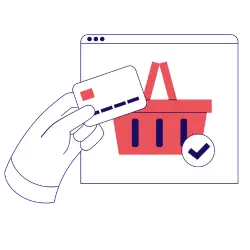As a modern business owner, you may be considering how a buy now, pay later (BNPL) service—such as Klarna—can elevate your operations. While the buy now, pay later market currently seems a boundless array of options, Klarna remains a prime choice among the crop. But is Klarna the prime choice for your particular business operations? The guide below details what Klarna is, how Klarna works, and even offers some alternative buy now, pay later options if you ultimately decide Klarna isn’t the best option for your operations.
What Is Klarna?
A buy now, pay later payment solution, Klarna enables businesses to offer customers financing options for purchases instead of paying for purchases in total upfront. Put simply, Klarna operates as a lender offering short- and long-term financing that is often interest-free.
Founded in 2005 in Sweden, Klarna currently serves over 205,000 merchants throughout 17 countries.[1]Investopedia. “How Klarna Lets You Pay Later With No Interest.” Accessed September 6, 2022. With Klarna, businesses can provide customers with the ability to pay for their purchases over time, in installments, without incurring interest.
How Does Klarna Work?

After a purchase, Klarna pays the merchant in full on the consumer’s behalf. Then, Klarna bills the customer for the purchase. Consumers can make the required monthly payments or pay their Klarna balance in full at any time.
If you implement Klarna in your business, your customers’ payment processes are processed through Klarna, after which the funds are transferred to your business.
Does Klarna require a minimum purchase amount?
Yes. To split a payment, Klarna requires a minimum purchase of $10.00 in the United States.[2]Investopedia. “How Klarna Works”. Accessed September 6, 2022.
Does Klarna set a maximum purchase amount?
No, Klarna does not set a maximum purchase amount. However, a consumer’s purchase eligibility depends on their specific financial circumstances. Klarna uses a metric called “Purchase Power,” which automatically evaluates factors, including a consumer’s Klarna payment history and outstanding Klarna balance.[3]Klarna. “How much am I eligible to spend? | Klarna US”. Accessed September 6, 2022.
What Are the Benefits of Klarna?
- Flexibility: By utilizing Klarna, businesses may offer their customers flexible payment terms. Customers are more likely to make a purchase if they know they can spread the payment out over time, reducing shopping cart abandonment and increasing sales.
- Ease of Use: Klarna is extremely easy to set up and user-friendly. It integrates with major eCommerce platforms, so merchants can quickly begin accepting Klarna payments on their preferred platform.
- Risk-Free: Because Klarna assumes the risks associated with its financing, merchants are protected from the financial consequences of customers who do not pay. Klarna also provides businesses with fraud and chargeback protection.
- Customer Loyalty: Klarna is a great way to build customer loyalty, as customers who have a positive experience spreading out their purchases via Klarna are more likely to become repeat customers.
What Are the Disadvantages of Klarna?
- Fees: Klarna charges businesses a fee for each transaction. This fee is typically a percentage of the total transaction value.
- Potential for Fraud: Because many buy now, pay later services rely on internal algorithms rather than traditional credit checks, vulnerabilities in internal systems are easy targets for fraudsters.
Is Klarna Safe to Use in Your Business?
Some businesses have been hesitant to implement Klarna’s buy now, pay later service because of fraud concerns. While it’s true that there’s a risk of fraud when accepting payments, Klarna has several safeguards in place to protect businesses. For starters, all transactions are heavily encrypted. In addition, Klarna monitors activity for suspicious behavior and offers 24/7 customer support. As a result, businesses accepting Klarna payments can rest assured their customers’ sensitive financial information is secure.
Does Klarna Check Credit?
Klarna does not perform a hard pull of your customer’s credit report, meaning it will not affect their score. However, Klarna still inquires about a consumer’s credit history, as well as their employment history and current income, during the application process. In general, consumers need a good or excellent credit score to qualify for Klarna financing.
Does Klarna Report to Credit Bureaus?
Klarna reports purchase and payment activity to the major credit reporting bureaus.[4]The Fintech Times. “Spotlight: Klarna to Start Reporting BNPL Data to Credit Agencies | The Fintech Times.” Accessed September 6, 2022. If your customer finances their purchase, their credit score can be damaged if they make a late payment to Klarna.
How Does Klarna Make Money?
Klarna makes money by charging merchants a fee on each financed transaction. Klarna also earns interest on the money shoppers pay over time. In addition, the company generates revenue through credit products and merchant services.

Klarna fees and interest
Klarna’s basic plans allow customers to choose to pay in four installments or within 30 days of the transaction date. Neither option is subject to interest as long as customers pay everything back within the set time period. If your customer misses a required payment, a $7 fee applies. Additionally, customers choosing to formally finance a purchase may be required to pay interest in the form of a variable APR of up to 24.99%.

Are there any interest-free plans?
Klarna offers two interest-free plans:
- Pay in 4 allows your customers to split a purchase into four equal payments made in two-week increments.
- Pay in 30 defers the whole purchase payment by 30 days.
The above payment plans are interest-free if payment is made in full according to the terms.
Where Can My Customers Use Klarna?
Though most commonly offered online, customers can also use Klarna when shopping in-store. Here’s how the two options work:

In-Store
If you set up Klarna in your store, your customer just needs to provide their phone number and email address to access financing. Upon purchase completion, your customer receives an SMS with a link to pay.

Online
If you set up Klarna at your online store, your customer only needs to provide their mobile number to access financing. Upon purchase completion, your customer is redirected to Klarna to finalize their payment.
How Do Klarna Payments Work?

Let’s talk about Klarna from the customer’s perspective. When customers purchase a product from a business offering Klarna, they have the option to pay with Klarna at checkout. When they choose this option, they’re asked to provide their email address and phone number.
Once your customer completes their purchase, Klarna sends them an instructional email or text message. Customers are generally allotted an agreed-upon number of days to pay for their purchase. They can make payments by logging in to their account via Klarna’s website or app.
If your customer is not able to pay within the set timeframe, Klarna works with them to set up a payment plan—though interest may apply at this point.
Is Klarna Right for Your Business?
Klarna is an excellent BNPL option, but it may not be right for your business. The service comes at a steep cost. For all payment plans, Klarna charges merchants a $0.30 transaction fee, as well as variable fees between 3.29% and 5.99% of the transaction total. However, merchants may assume they’ll make up for these costs via their increased volume of sales.
As for whether Klarna is right for your business, there’s no one-size-fits-all answer. Ultimately, it depends on several factors, including your business model, average order value, and customer base. However, below are a few general guidelines to help you decide if Klarna is a good fit for your business.
Klarna is a good choice for:
- High Shopping Cart Abandonment Rates: If your customers regularly abandon their shopping carts without making a purchase, Klarna can boost your business’s shopping cart conversion rate and even increase your business’s average transaction size.
- Unknown, New, and Untested Businesses: From the customer’s perspective, Klarna can legitimize your business. Klarna’s brand reputation serves as a layer of protection for customers, which is ultimately invaluable.
Klarna is not a good option for:
- Businesses with a $1,000 or Higher Average Ticket: Your customer will likely not qualify for financing through Klarna if the transaction total is deemed too high. This can create a negative experience for customers wishing to purchase large ticket items yet denied financing.
- Businesses with Lower Profit Margins: If your company operates with a lower profit margin, the additional fees may outweigh the potential for increased sales.
Are There Any Alternatives to Klarna?
Yes, Klarna has many alternative options for merchants and consumers alike.

For Merchants
- Other BNPL services—Afterpay, Sezzle, and Splitit, just for starters—may be better options through which you can offer customers the same benefits yet unlock more favorable terms for you as a merchant.
- A merchant account is an excellent alternative to buy now, pay later services. A merchant account gives business owners more control over the transaction process and how much they pay in fees.

For consumers
- Credit cards are the original buy now, pay later tool. Consumers with good credit may qualify for credit cards incurring no interest for a set period, similar to Klarna’s payment option.
- A personal loan might be considered by your customers if your products require a steep financial investment.
Klarna for Business: Final Thoughts
Utilizing Klarna for your business’s operations is an excellent method for boosting sales and building customer loyalty. However, these benefits do come at the cost of additional fees incurred on financed transactions. If these transaction fees deter you from implementing Klarna or any other BNPL service, consider partnering with a merchant services provider to unlock lower credit card processing fees. With lower payment processing fees, you may just find a buy now, pay later service within your budget!
Leave your provider in tiers!
Get a better rate through us.
my free quote
Transparent
FAQs about Klarna for Business
Can using Klarna hurt my customers’ credit scores?
Yes, using Klarna can impact your customer’s credit score. In particular, missed Klarna payments can damage their credit score.
Is there a catch with Klarna?
There is no catch with Klarna, but there are pros and cons to using this service.
- Pros: You can offer interest-free financing to your customers from a widely trusted company.
- Cons: Purchases financed with Klarna are subject to transaction fees, eating into your business’s revenue.
How does the Klarna app work?
The Klarna app allows customers to make purchases and track their purchases. Like many other apps, customers search for items and add them to their carts. The difference is that during the checkout process, customers click the “Check out with Klarna” option. This allows them to choose their desired payment and credit card options.
How do I handle returns when using Klarna?
Once a return has been made, Klarna gives the customer three options:
- Full Refund: The full purchase amount is refunded to the same account.
- Partial Return: Payments remain the same, but customers end up paying off the balance sooner than expected.
- Partial Repay in Four Payments: Klarna credits the return based on the customer’s balance. If the return is larger than the payments, customers receive the extra funds via the original payment method. If not, Klarna adjusts payments considering the owed balance.






